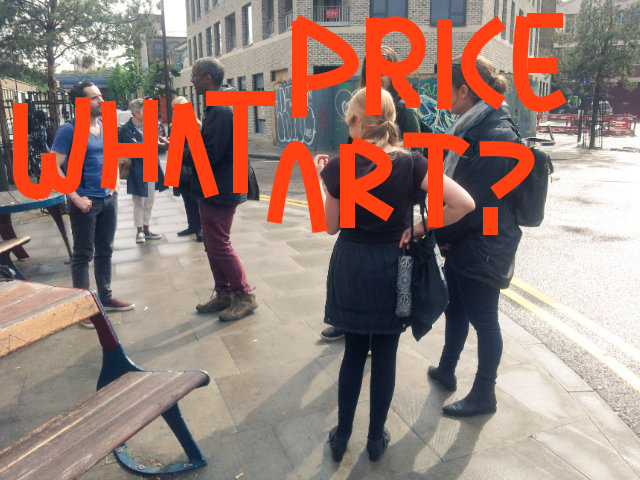
On Saturday there was a protest against the intended demolition of part of Vittoria Wharf to build a bridge that many think is unnecessary (see the Save Hackney Wick petition here or the environmental case on BBC News here) and could be the last nail in the coffin of an arts community that made Hackney Wick what it is today.
The Artwashing and Gentrification argument is well known: why should other people’s creativity be allowed to be turned into big profits for land owners and developers if it comes at the cost of displacing the people who made the area ‘cool’? No dividend for them, not even able to stay on and be part of the new (expensive) community?
But why do the Arts matter anyway? What is the role of the Humanities in 2018? Why are spaces that are unconventional key to an interesting, diverse and – crucially – evolving city that’s going growing not just in terms of economic output or population?
I’m always struck by the similarities between certain bits of East London and East Berlin, or at least East Berlin as it was until recently. Empty – or at least cheap – spaces facilitate enterprise and creativity. From the secret or squat nightclubs in the German capital that appeared one month then disappeared the next, to the East London warehouses where people enjoy the supportive environment of communal living, space that isn’t a tiny flat costing you the earth is crucial to subcultures and other modes of living.
And it’s not just Anthropologists and Arts-lovers who need this variety, this ‘scene’ has been part of the sales talk by companies and councils to investors by across the globe, in places as diverse as Singapore and South By Southwest festival in Texas.
I once asked a council regeneration office if they were aware that they might “kill the goose that laid the golden [regeneration] egg?” People aren’t stupid, of course he was. There has been talk of a ‘London Doughnut’, an allusion to the ‘Paris Doughnut’. Paris is effectively two different cities depending on whether or not you can afford to be inside the Peripherique or you’re in the Banlieues; imagine the North and South Circular as a major geographical and cultural divide.
For some time, Anna Minton the writer and academic has been asking who London is for. Is it for “Big Capital”, the title of her recent book? Or is it for people like those in warehouses across London living what academics call ‘Precarity’.

I’ve wondered the same thing myself (see this walk for Antiuniversity. If the city is to be some kind of Shanghai-like special zone totally dedicated to bringing in as much money as possible, a city where it’s not intended that people should stay and invest themselves physically, financially but also emotionally, then let’s be honest about that?
But if it’s to be a city to grow old in, a city to grow mentally in, then it’s going to take some work. Just leaving it to the Free Market isn’t going to cut it. Whether you agree or not that your roof should be someone else’s investment opportunity, just letting the commercial imperative dictate everything is going to favour lowest-common-denominator monoculture over works or activities that add the necessary flavour to have a truly great city.
There’s a certain irony in flying to places like East Berlin for its quirky subcultures and rich variety of lifestyles and low-budget culture, whilst simultaneously all but eradicating it here? If everyone has to work 40 hours a week in an office just to keep the roof over their heads, who’s going to find the time to do anything interesting or offbeat?

Go back to 1976 and you can read Paul Simenon of the Clash saying how important ‘the Dole’ was to the band’s formation: “We get a little freedom from social security. Otherwise I’d have to spend 40 hours a week lifting cardboard boxes or washing dishes, or what ever I done in the past. But because we’re on the dole – which is £9.70 a week – I can get a rock’n’roll band together.”
The Clash were able to practice in the empty (cheap) space under a pre-commercial Camden Market that was a celebrated part of the Punk explosion of 1976. They hung out in parts of Notting Hill that were then more like Haight Ashbury than the location of a Hugh Grant film.
I’m not suggesting that Hackney Wick was full of people who were unemployed, but a lower-rent environment where you were surrounded by other creative people, people who had time to make stuff, who would turn up to your art show if you put it on – an environment sometimes longingly referred to as a ‘village’ vibe by those who remember it at its height – this lent itself to people trying stuff. You could take risks. You could make an installation and if it wasn’t quite what you wanted to be, it hadn’t cost you too much. Hackney Wicked was only a public tip of a creative iceberg.
Here is a quote from Dr Christine Wall (Westminster University) in an academic article (History Workshop Journal, Apr 2017) about the role that freedom from high rent and collective living played in forging new ways of being for women in 1970s Hackney.
“This historic spatial configuration of the city allowed the social and political movements of the 1970s to flourish, as groups of like-minded people began to live and work in close proximity. For women, it enabled radical experiments in collective living and shared childcare and for some feminists, active in the women’s liberation movement, it provided the framework for an extensive network of women-only housing, together with social and political spaces.
“The antithesis of suburban life was found in the everyday, lived experience of women’s squatted communities, which enabled collective living, shared childcare, and the means to live outside dominant power relations. Equally important at the time, was the act of engaging directly with the built environment, adjusting, repairing and adapting it by women and for women, and making these communities unique.”
Unconventional spaces were part of a key phase not just in Punk but in the struggle for gender equality too. This is the era and location that gives us “Spare Rib” and the “Hackney Flashers” – women pushing the boundaries and asking the questions of society that others don’t have the time or ability to do, in order for it to evolve and progress.
Wall’s paper pertains to women-only squats in Hackney in the 1970s. But it could just as easily apply to London’s contemporary warehouse scene, as demonstrated in what remains of Hackney Wick. Even those with regular jobs that allow them limited thinking time get to experience what it is to live in a group and be part of something bigger than themselves and their small flats.
In a city that’s sometimes hard to penetrate, where it can take a long time to make friends, this environment can play an important role in maintaining your mental health.
DIY warehouse culture is active culture and creates, in contrast with the passivity of mono and mass culture which focuses on consumption. Why should the latter help people grow and make their own culture when you can make a ton of money selling stuff to them? If we are to avoid a sterile homogeneous city where the only Arts activity is expensive and commercial – great as these ‘big shows’ are – then we need to create space for the Arts and especially for the kind of creativity that isn’t necessarily the most saleable.

Mass consumption relies on the lowest-common-denominator, undemanding art and conventional lifestyles – the kind of stereotypical “Mum’s making chips while Dad plays football” isolated nuclear family themes that Advertising loves. Art that requires thought or growth is a harder sell. But this is where society grows and evolves, not in yet another formulaic TV cop drama that requires nothing more from you than moving every hour so your bum doesn’t get sore.
It’s hard to make art that takes us a little further or incorporates a lot of thought and creativity if you’re constantly trying to make ends meet or having to work 40 hours per week first. And art really does matter, not ‘just’ for our mental health and soul: the ‘creative economy’, the one that is so easily tossed aside once it’s been used to regenerate an area and raise the land value, is credited with being a major part of the rise of the ‘new East London’.
The Olympics is only part of it. Some even argue that it takes the credit for what was already happening, like the redevelopment of Stratford’s high street.
David Sloan Wilson, philosopher and author of Does Altruism Exist?: Culture, Genes, and the Welfare of Others (2015) said: “…all the activities associated with the Arts can be really be seen as group solidarity mechanisms. They’re actually the mechanisms that cause groups to function as organisms”. The Arts are how we communicate, how we process things, how we evaluate values and meaning in a group space. It’s how societies define themselves publicly, in a tradition that goes back to the Greeks.
There’s a similarity with what’s happening here with the Humanities and university debate. At Doomed Gallery in Dalston, a free Humanities course has been running. Why? The academic involved feels like Humanities is being pushed to one side as universities focus on where the money is, but that the Humanities are so important that they will give the teaching for free to those who want to get better at understanding and processing the world. And in 2017 in the public/political sphere we saw how tricky that can be sometimes.
Some will see a pattern: activities that encourage us to interrogate the status quo being marginalised and passive consumption being encouraged: “Obey, buy, die” as one t-shirt put it. At the very least, in the money city London, revenue shapes how we live and what our lives look like. But if we just go where the money is, there’ll be no progression in art.
There’ll be none of the dissenting voices that you need in a society, no canaries in the coal mine – the ones who provide the impetus for reform. The Arts may become a ‘playground of the rich’, the fear of Dalston-based Arts Emergency who pair mentors with local youth unsure about taking the ‘I love the Arts but will it provide me a living’ plunge at university level.

I often come back to the analogy of Burning Man festival in the Nevada Desert. It needs tech types and engineers to provide the infrastructure that can support 60,000 in the barren desert for a week. It needs methodical organisers to make sure everything comes together at the right time. It needs paramedics and some police.
But it’d be a dull event without the ‘out there’ performance artists who create – hand in hand with the engineers and builders and facilitators – incredible sights. I’m not saying that it’s a blueprint for society, but it’s a great example of how we need not just the bottom foundation of Maslow’s hierarchy of needs but also the ‘self-actualisation’ peak of the pyramid.
If you want to sign the Save Hackney Wick petition, there’s still time. But let’s leave the last word to Dr Wall, talking about the environment the squats* of Broadway Market created for 1970s lesbians who travelled from places they felt isolated and stifled to a place where they could grow:
“It was in some senses utopian: an opportunity for self-determination, to live autonomously, to imagine and create a different world.”
* people in Hackney Wick have been paying rent, but it was lower and for a kind of space that was more open to innovation than regular rented accommodation
